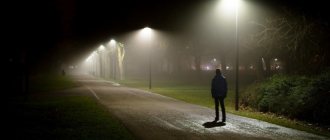Residents of modern cities quite often face a complete or partial lack of street lighting. This issue is especially relevant in the winter and transitional periods of the year. Non-working lights impair visibility in the yard, which can be dangerous for residents and passers-by.
To find a solution in this situation, consider who is responsible for street lighting in the city and where to complain in this case. A city dweller, armed with the necessary information, will be able to react correctly if there is no light on the street and contact the appropriate authority to solve the problem.
Standards and requirements
To have an idea of how to defend your rights in the event of a lack of lighting, you need to understand how street lighting is arranged. The main points of SNiP rules and building codes are:
- monuments and architectural objects must be illuminated,
- lighting of main and secondary roads is carried out taking into account the type of road surface and its ability to reflect light,
- For each individual object, a specific level of horizontal illumination is provided, so for highways this value corresponds to 20 lux, for regional roads - 15 lux, for streets 4-6 lux is enough.
Watch the video: How city lighting works
Procedure
Each situation has its own algorithm of actions.
The light went out in the dark
Responsible executive authorities do not independently maintain lighting fixtures. They delegate these powers to contractors on the basis of contracts. Moreover, the contract can be concluded directly with the power grid organization (road lighting), or through third parties. For example, the improvement of a city park is carried out by a commercial or utility company based on an agreement with the municipality. But the lanterns and other devices are serviced by energy retailers.
It has long since dawned, and the lamps are burning. Source: pixy.org
It is the latter organization that is obliged:
- monitor the condition of electrical appliances;
- adhere to the schedule for turning on and off outdoor lights established in the locality;
- replace burnt out lamps and broken lanterns;
- eliminate any malfunctions, including those related to natural disasters or emergency situations.
Therefore, if the light is on during the day and not at night, the lamps are not screwed in for 1–5 days, we file a complaint with the organization that services the facility, most often these are local electrical suppliers. We also call here when wires are broken due to bad weather, a pole falls, or other emergencies occur.
The second copy of the complaint can be immediately sent to the customer under the technical equipment maintenance agreement. Let us remind you that this may be the city administration or third companies. You can find out who is responsible for what at your local government office.
If there is no result, we file a complaint with the municipality. They also do not respond - to a higher executive body.
In many cities there are unified centers for citizens to address housing and communal services issues or Unified Duty Dispatch Services. For example, residents of the Moscow region can leave a complaint on the portal or through the Dobrodel application.
The opportunity to leave a complaint for any region has also appeared on the State Services platform. Let's decide together."
Interesting! In May 2021, through government services, residents of the Samara region alone complained about lighting problems more than 500 times. All requests have been forwarded to the municipality for processing.
It is necessary to take into account the exceptions prescribed in SNiPs, which allow that lamps may not work:
- 5% – on the streets and in courtyards;
- 10% – in underground passages.
Repairs must be carried out after receiving the application no later than 5–15 days. But some regions may set their own shorter deadlines. On/off schedules are approved by separate documents locally, taking into account the time zone and other nuances. During repair work, the lamps may remain on during the day.
To the point! Where to complain about a power outage.
No money for dark alleys
The question is much more difficult when there are no lights at all or there are not enough of them. In this case, you must contact the administration immediately.
Based on the request, they are required to create a special commission, which, after an examination, must conclude whether additional lighting points are needed for this area.
“The decision is made by the general contractors based on the design and plan approved by the authorities.
When determining how many lamps need to be installed on a certain street, several documents are taken into account: GOST on external utilitarian lighting and on roads and streets, building codes and regulations (SNiP 2.07.01-89 and 23-05-95). Thus, the following factors are taken into account: the type of settlement, its geographical location, the category of roads and streets, the type and brightness of the road surface, traffic intensity" Dmitry Pantyushin
The issue of installing lamps is difficult to solve in towns and villages, since the problem comes down to funding. But this does not mean that the executive branch has the right to ignore citizens’ appeals.
In the village the only light comes from the windows of the houses. Source: wallup.net
If the complaint is ignored or replies are sent in response, write to public services or contact the prosecutor's office.
The prosecutor will order an inspection, on the basis of which he will initiate legal proceedings. Courts most often take the side of citizens and recognize inaction as illegal, and decide to impose an obligation on local authorities to take measures to organize lighting.
Note! You can contact dispatch services by phone or in person. If you make a complaint to the administration or an application to the prosecutor’s office, they are drawn up in writing in two copies with the obligatory indication of the essence of the problem and the requirements. There is no approved form for such complaints.
Types of pillars and the order of their installation
In order for the level of light to be sufficient for the designated area, it is necessary to install the lamps at a certain height. Special supports made from different materials are designed for this:
- Tree. Mainly coniferous species are suitable for this. The cost of such poles is low, they are light in weight and easy to install. They are also quite safe in emergency situations. However, they are not durable and require treatment against rotting.
- Concrete. Their price is also low, easy to use and have a long service life. However, groundwater flow is undesirable near such supports.
- Reinforced concrete. This type of support is durable, not subject to corrosion, and inexpensive. But it requires high installation and maintenance costs.
- Metal (aluminum or steel) . Although the price of such poles is quite high, they are strong and durable.
When installing supports, it is important to pay attention to the foundation. The depth for lawn installation cannot be less than 80 cm. For other types of installation, the depth should not be less than 160 cm.
Other requirements include:
- the gap between the supports must be at least 60 cm,
- installation of supports in one row,
- the supports are arranged in two rows in a checkerboard or rectangular pattern.
The distance from the road curb is affected by traffic intensity:
- if there are no trucks on the roads - 0.3 m,
- secondary roads – 0.6 m,
- highways – 1 m.
Lighting standards
Lighting standards for the local area of an apartment building are established in accordance with SP 52.13330.2011, namely:
- there must be at least 6 suites at the entrance to the building;
- there must be at least 4 suites on the pedestrian path leading to the building;
- main passages running in microdistricts should be illuminated at 4 lux;
- secondary passages, as well as courtyards and various utility areas should be illuminated within 2 lux.
In addition, there are pre-designed lighting options. They provide for a specific placement of lighting fixtures and their corresponding type. The options are as follows:
- Option number one involves having a lantern under the canopy above the door to the entrance.
The flashlight can be anything, even LED.The advantage of this option is its low cost.
This is due to the fact that the flashlight does not require much power. The disadvantage is that only the space in front of the door is illuminated, and the approaches are in the dark.
- Option number two involves placing the lighting fixture on the wall of the building directly above the driveway canopy. The flashlight is located at a height of approximately 8.5 m. In such a situation, you need to use a lamp that has a circular luminous intensity and can produce a luminous flux equal to 3600 lumens.
In this case, the lantern should be located at an angle of 25 to the horizon. With this method of lighting, only the space in front of the front door suffers. The shadow from the entrance canopy falls there. - The third option involves using both types of lantern placement at the same time. This measure more than satisfies all lighting standards for the local area.
However, the cost of maintaining such lighting will be, by definition, high.
When residents are faced with the task of designing lighting for their yard, in addition to the financial component, they must take into account such factors as the resistance of the lanterns to hooligans and protection from falling icicles in the winter.
Whatever option the citizens living in the house choose, they must first of all be guided by the lighting standards that are adopted in Russia.
They were invented for a reason, and failure to comply with them can result not only in liability before the law, but also in some human casualties.
Types of lamps
Different lamps can be used for street lighting:
- sodium,
- mercury,
- LED,
- metal halide lamps.
You can increasingly see LED lights. The main differences between LED devices are:
- efficiency,
- strength,
- durability,
- resistance to moisture, temperature changes,
- uniform bright light.
Street lighting is necessary in order to ensure safe traffic movement, the convenience of pedestrians, and a sense of security in the dark.
Where and how to contact
Do city residents who are dissatisfied with the quality of street lighting know where to complain that commercial organizations are not fulfilling their duties in good faith? The solution to the problem depends on the citizens’ knowledge of their rights and laws, since if lamps near the house break down and there are no street lights, they must contact different authorities.
City residents, depending on the identified problem, have several options to correct the situation. They can contact the following organizations:
- City Housing and Public Utilities Service . The organization operates and maintains street lighting networks, including turning street lights on and off.
- City administration or executive committee . The organization is responsible for strict compliance with the standards and requirements established for the organization of high-quality street lighting.
Who is responsible
According to the law of 06.10.2003 No. 131-FZ “On the general principles of organizing local self-government in the Russian Federation”, the territories of residential buildings, microdistricts, blocks, industrial organizations and communal services, alleys, roads, streets, bridges, boulevards, and therefore courtyards, are located under the control of local authorities.
Read also: Structure of local governments.
ATTENTION! Article 16 states that the city administration establishes a lighting schedule at night at the listed facilities. However, building owners must maintain lighting.
Energy-saving organizations, which are commercial structures, are engaged in lighting urban areas. They draw up an agreement with a local organization or other persons and provide them with their services. The construction and repair of power lines is entrusted to the same specialized organizations with which the administration enters into an agreement.
Read also: Power transmission line security zone: what you need to know before buying a plot
However, this all applies to public areas (gardens, parks, squares, boulevards). Yards are not included in this list.
They belong to the local area. This is completely different. This area is intended for recreation, playgrounds, sports, plantings, sidewalks, and parking. The Housing Code of the Russian Federation (Part 2, Article 162) states that an agreement is drawn up between the owners of apartments, the partnership, the management body of the housing cooperative, and sometimes with the developer and the management company (Part 14, Article 161 of the Housing Code of the Russian Federation).
The agreement contains information about services and work related to the maintenance of common property and its repair, as well as the provision of utilities. Such services are paid. The Housing Code of the Russian Federation (Parts 1 and 2 of Article 154) states that their fee is included in the receipts for payment for the services provided.
Read also: Mosoblgaz - how to find out the debt on a personal account?
Scope of activity of the service dealing with outdoor lighting
The street lighting service carries out maintenance, maintenance and repair of structures, namely:
- prevention and maintenance of structures;
- changing lamps, monitoring the health of equipment and electrical networks;
- inspection of distribution devices and regular cleaning;
- inspection of telemechanical control devices, street lighting installations, checking all structural elements;
- cleaning reflectors and reflectors. Minor repairs of contact connections and fasteners;
- painting of metal surfaces of devices, taking into account the fact that restoration of coatings is necessary once every 3 years;
- current repairs with a range of measures;
- major repair work.
In the case of manual control of the lighting system, schedules are drawn up for turning on and off devices.
No light on the streets or in the yard
First you need to identify the problem:
- light bulb needs replacing
- poor lighting or additional lighting required,
- there is no lighting.
If there is visible damage to the light bulb, you can first report it to the housing and communal services manager. The telephone number is provided on the website of the corresponding company.
If the problem is not solved, you need to go to the City Administration, since it is the one who enters into an agreement with the electrical networks.
Lighting in villages and rural settlements
In rural life, the issue of illumination of the territory is almost always acute. Even if there are a sufficient number of devices, as a rule, they do not light up at night or are turned on only for a few hours. SNiP 05/23/95 regulates the lighting standards for village squares, according to which at least 8/10 of the territory must be illuminated. The only exceptions are very small settlements, where the standard establishes the presence of two street lights: at the entrance and exit.
Financing for rural areas is provided by the Federal Treasury. The money is distributed by the administration, which makes decisions about the installation and operation of the lighting. The local municipality, according to Law No. 131-FZ, is responsible for the maintenance and provision of lighting.
However, there is always not enough money; there is nothing to pay energy sales departments for repairs or other technical work. Therefore, today the problem of lighting in rural areas is still not solved, however, like many other issues of the development of villages and agriculture in general.
Villages and towns
The budgets of villages and small towns do not always adequately finance street lighting. Installing lights near every road is quite expensive. Every year, a plan is drawn up to supply street lights and local authorities review it according to the budget.
IMPORTANT! There are certain places where the installation of lights is mandatory, such as road intersections, where the likelihood of accidents is high, as well as educational institutions and administration buildings.
The district department of Energosbyt is responsible for maintenance, but control over the implementation of its duties is entrusted to the local municipality. The right decision would be to contact them orally, in writing (by filing a complaint) or simply by calling.
If there is no lighting along the street or in the courtyard of a residential building, you should contact the relevant authorities with this issue. However, you should not hope for a quick solution to the problem, since it cannot be solved with lightning speed.
The answer to the question of where to complain if there is no lighting on the streets will depend on the territory in question.
The lights in the city are not on
Under the right operating conditions, the lamp in a street lamp can last at least 1.5 years. In certain regions of the Russian Federation, lighting may be used at different intensities due to weather or geographical conditions.
If the lamps are turned on frequently, they may become unusable faster, but if used less frequently, they can last up to 4 years.
If the lamps in the streetlights have burned out or there is not enough lighting on your street, you need to take action. This will allow you to avoid dangerous situations - an increase in the number of thefts, accidents and cases of injury to passers-by in this area.
If the street lamp does not light, you must contact the local municipal administration. The best option is to file a collective written complaint.
What to do if you are refused?
The response from the local administration must be received by the applicants in writing within a calendar month from the date of filing the complaint. Failure of a local government body is a common phenomenon, the reason most often being a lack of finances in the budget. In such a situation, you will need to contact a higher authority - the court or the prosecutor's office.
However, you should not immediately sue the municipality due to the lack of working light bulbs in street lamps. First, try contacting your local government and the organization that maintains a specific street or section of it (this information should be provided to you in a written response from the administration).
If there are no lights at all on a particular street, which creates an increased danger for passers-by and residents, but the municipality refuses to install lighting in this place, interested parties are advised to go to court to resolve this conflict.
The text of the application must indicate the fact of inaction of executive authorities. In addition, it is recommended that photographs confirming the absence of lighting be attached to the application.
Repairing cracks in an apartment - who should do it?
The management company does not respond to statements? Find out where to complain about the Criminal Code.
Find out how to file a complaint against housing and communal services in this article.
Peculiarities
The main purpose of urban street lighting is to ensure the safe movement of vehicles and pedestrians. This category includes lighting of various territorial areas of the city, including squares, overpasses, bridges, tunnels, parking lots, vehicle parking, roadways and pedestrian paths.
ATTENTION! Lanterns located above entrance doors and on the facade of residential buildings do not belong to street lighting.
Lighting, like any service, must be provided in compliance with established norms, standards and requirements. In the city, at least 80% of the length of streets must be illuminated.
The level of lighting in a certain area depends on the intensity of vehicle traffic, infrastructure development, population density in the area, energy efficiency and local budget capabilities.
Central streets and boulevards should be illuminated much better than areas located on the outskirts of the city.
Street lighting is turned on and off strictly according to a schedule, which may differ depending on the extent and population density in the locality. In different cities, this schedule may be the same or radically different. Regardless of this, lighting devices are turned on and off at different times - the longer the daylight hours, the later they light up.
If there is snow, rain, snow or fog outside, street lighting is turned on earlier and turned off later than scheduled with a difference of 15 minutes.
Where to go if street lighting in Dnepr does not work?
Reference. With complaints and suggestions regarding street lighting, Dnipro residents can contact the unified city contact center by phone: 056-732-12-12, 095-732-12-12, 096-732-12-12, 073-732-12 -12 or via the Internet. All applications will be sent to the Gorsvet CP for processing.
Interesting materials:
How long does it take for carrots to sprout on a tape? How much did Khabib win for the fight with Conor? How many gates are there at Vnukovo airport? How long should lard be soaked before smoking? How long does it take to drink two glasses of champagne? How long does it take to beat the whites until stiff peaks form? How many adults are there in Kazakhstan? How many tasks are there in the Unified State Exam in Biology 2021? How many requests per second does Google process? How many Earth days is a day on the Moon?
Why is it better to trust lighting maintenance and repair to specialists?
In order to efficiently perform lighting maintenance and repair services, specialists must have knowledge of the construction and topology of electrical networks. Understand what characteristics equipment should have for a given network configuration; what are the possibilities for its expansion and methods of operational management. You need to know what equipment is best to use for quick diagnosis and repair, and be able to handle the tool correctly. Sometimes it is necessary to replace part of the electrical network in order to prevent subsequent frequent breakdowns. You need to be well versed in this matter.
This requires not only professional knowledge, but also extensive experience. has been repairing and maintaining electrical networks for more than 20 years, so we carry out orders of any complexity: from eliminating minor faults to major repairs.
Who is responsible for lighting the house?
According to Federal Law No. 131, local governments are responsible for the lighting of streets, roads and courtyards. But maintaining the functionality of the lamps is the responsibility of the residents of the house.
According to the Housing Code of the Russian Federation, responsibility for light inside residential buildings and in the local area lies with the management company with which the residents entered into an agreement. The text of the agreement states what services the management company provides, what it is responsible for, and what the procedure is for dealing with problems or controversial issues that arise.
What to do if residents find that there is no light in the entrance, common areas, basement or adjacent area? They need to take the following steps:
- An act is drawn up that describes the problem.
- The act is signed by at least 3 people. These could be neighbors, a senior person in the building, or the chairman of the house.
- Evidence of the existence of the problem is attached to the report. For example, a photo of the absence of light in the evening.
- The documents are transferred to the management company.
- Within seven days, management company employees check and analyze information, troubleshoot problems and draw up their own report on the problem.
- A document detailing all actions taken to resolve the problem is handed over to the applicants.
If the management company fails to fulfill its responsibilities and refuses to fulfill what is specified in the contract, residents have the right to terminate the agreement with it and enter into an agreement with another organization.
Who pays for the lighting of the courtyard and entrances of an apartment building? According to the Federal Law, the area around the house, like the entrances, is common property. The costs of lighting and troubleshooting are borne directly by the building occupants. Moreover, the costs are divided for each owner depending on the area of his apartment.
You should pay attention to whether it is documented that this particular local area is the common property of this particular house. If there are no such notes, then inclusion of payment for it in the receipt is unlawful.
Lighting in multi-storey buildings is strictly regulated by laws and sanitary standards. If one of the important parameters is not met - there is no light at all, it is not bright enough, the lighting is organized without taking into account the safety of the residents, then the residents of the house have the right to apply to the management company, the local administration or even to the court.
Didn't find the answer to your question? Find out how to solve exactly your problem - call right now: +7 (Moscow) +7 (St. Petersburg) It's fast and free!
Residents of populated areas are often faced with a lack of street lighting. If one or more lights are not working, visibility in the yard is impaired and may cause increased danger to passers-by. Are you wondering who should deal with this situation? You will find the answer to this question in the article.
More about functional usage
Lanterns on the roads solve several problems at once: they provide relative safety in the dark, illuminate the area and give the area some attractiveness, adding a feeling of comfort. Street lighting is divided into types according to different parameters.
There are lamps that differ in their intended purpose:
- Lanterns;
- Architectural lighting;
- Decorative lighting.
Lamps can also be used in different types: sodium, mercury, metal halide and LED. Sodium lamps are most often used on poles illuminating roads, sidewalks, squares and parks, but LED lamps are gradually being introduced. Lanterns are also presented in a variety of options, differing in the type of material of the supporting structure, the shape of the bracket and the shade.
The lighting can be controlled automatically or manually, it all depends on the type of lamp. But gradually there is a transition to automation. However, servicing lamps requires the regular participation of qualified workers, so it is not yet possible to completely switch to automated control of the lighting system.
Rules for filing a complaint
If a lamp or lighting device has failed and as a result the lantern does not light, you must contact the management company in your area. If a light bulb burns out or is missing in a lamp located near the house, on the facade or entrance, you must contact the housing and communal services service.
You can complain, ask a question you are interested in or make a rational proposal on the topic of lighting city streets to the relevant organizations orally and in writing. Verbal options:
- if there is no light on the street, you need to call the unified housing and communal services dispatch service at telephone number 115;
- you can call the operational dispatch service of the city's Gorsvet system enterprise, the hotline of the executive committee or the housing and communal services service;
- make an appointment with the executive committee or the head of the housing and communal services service.
When calling, be sure to introduce yourself, give your home address and briefly state the essence of your request.
You can complain about poor city lighting on the street or in the courtyard of a residential building in writing by following simple recommendations:
- Send an appeal by email or post a complaint on the website of the housing and communal services service (executive committee) in a special section.
- Write a complaint and bring it personally to the executive committee or housing and communal services service. If desired, it can be sent by courier or by mail.
In written and electronic appeals, you must indicate your contact information (last name, first name, patronymic, registration address and telephone number), date and highlight the essence of the appeal. A written appeal must be signed, and an electronic version must include an email address.
If the lights in your city are partially out of order or there is no lighting system, as often happens in new neighborhoods located on the outskirts of the city, the problem must be solved immediately.
IMPORTANT! When contacting the relevant authorities, you will have to prepare for the fact that such issues are rarely resolved instantly.
The local Administration is responsible for lighting on the streets and courtyards of cities. She must be responsible for the absence and insufficient lighting of city streets, and after filing a complaint, within a month, correct the current situation and ensure the safety of area residents and passers-by.
15.1. To ensure the safety of vehicles and pedestrians, as well as to increase road capacity at night, stationary lighting installations are provided. When designing them, the following requirements must be met:
when choosing the type and method of placement of lighting installations, ensure illumination of roads in accordance with the standards for the average brightness of the roadway and the average horizontal illumination of roadsides and sidewalks: uniformity of brightness distribution (the ratio of the maximum brightness at individual points of the roadway to the minimum); blindness rate;
identify and emphasize the location of dangerous zones (intersections and junctions, narrowing roads, pedestrian crossings, bus stops) by changing the color of light sources, placing supports and lamps, increasing the brightness of the roadway in the dangerous zone;
provide visual orientation for drivers on the road thanks to the rational placement of supports and lamps, changing the color of light sources on adjacent roads, limiting the disorienting effects of advertising lights, store windows and security lighting of objects located near the road;
prevent sudden changes in illumination in front of complex and dangerous sections of roads and alternation of illuminated and unlit areas, arranging continuous lighting when illuminated sections of the road are located at a distance of less than 250 m from each other;
achieve a smooth decrease in the brightness of the roadway at the exit from the illuminated area to the unlit one, arranging a transition zone 150-250 m long;
strive to use elements of lighting installations that meet aesthetic requirements and do not interfere with the appearance of the architectural ensemble of the road and the structures located on it;
avoid placing lighting poles on those elements of roads and intersections where their installation may cause road accidents;
use supports that do not provide much shear resistance when a car hits.
15.2. Stationary lighting on highways should include:
in populated areas (according to SNiP II-4-79, part II, chapter 4. Design standards. Natural and artificial lighting);
on category I roads with an estimated traffic intensity of 20 thousand vehicles/day or more, achieved in the first 5 years of operation;
on medium and large bridges (overpasses) in accordance with the recommendations of table. 15.1;
How we are working?
If necessary, we carry out energy audits and complete modernization of the electrical network based on new energy-saving technologies. Lighting created on the basis of modern equipment is significantly different from the usual: it is brighter, more comfortable for the eyes, and looks more natural. Look at the work in our portfolio and you will be pleasantly surprised.
Installing modern systems can significantly reduce the cost of electricity consumption due to solar panels, programmable controllers, and motion sensors that turn on the lights at a given time or only in the presence of people.
Courtyard lighting - how to properly illuminate
Any actions that relate to the organization of lighting in a house, on the street or in any public or industrial structure must be based on specific norms, rules and requirements. Many today think that the requirement is relevant only for premises where people do their work or relax. But this is a misconception, since improperly organized street lighting can cause no less harm to people’s lives and health than indoor lighting. All standards that relate to what kind of lighting should be provided for an apartment building and the surrounding area are specified in the regulatory documentation - SNIP. At the same time, a big role here is given to the level of illumination, which must be organized in each specific situation. Below is a table that shows the illumination standards for certain moments of external lighting in the local area.
Standards for illumination of the local area
It is these lighting standards that should be relied upon by organizations involved in the creation of street lighting for houses and the surrounding area.
At the same time, cities and villages have their own lighting standards, dictated by various parameters and characteristics of the locality. For example, to influence the calculation that will be carried out to calculate the illumination standard for a particular case, it should be based not only on the instructions of SNIP, but also on:
- the area of the house, as well as the territory adjacent to it;
- the number of lighting fixtures that will be included in the outdoor lighting system, as well as their type;
House lighting fixtures
type of light source screwed into street-type lamps. Today, incandescent lamps, on the basis of which illumination standards were calculated for various rooms and areas of the street, are becoming a thing of the past. Instead, LED, halogen and fluorescent light sources are increasingly being used. Each type of light bulb has its own operating parameters (power, etc.), which must be taken into account when making the necessary calculations.
All these manipulations and calculations, which are necessary for high-quality lighting of the house and the surrounding area, must be carried out by qualified specialists and regulated by government agencies responsible for street lighting.
The adjacent territory of an apartment building. Standards
Utility workers often treat house maintenance carelessly, and there is no discussion at all about the adjacent areas. Therefore, the maintenance of the local area of an apartment building falls entirely on the shoulders of the residents. And in order to improve the area around the house, you need to know its boundaries.
The size of the adjacent plot is determined by town planning regulations in accordance with Article 43.4 of the Town Planning Code. Each city has its own regulations, but there is a general formula by which the adjacent territory of an apartment building is calculated (it is important to calculate the 2021 standards using this formula, since the legislation on this issue has not changed since 2000).
According to the Regulations on determining the boundaries of land plots in condominiums, it is established exactly how to determine the boundaries of the local area. In this case, the parameters and characteristics of the high-rise building, the boundaries of neighboring houses and the area of the entire microdistrict must be taken into account.
- Snorm – standard area area;
- U – indicator of the share of land per 1 sq.m. housing, which is calculated using a more complex formula and directly depends on the number of storeys of the house and the year of construction;
- Sк – total area of apartments and common property.
The formula for calculating the share indicator can be found in the town planning regulations of your municipality.






